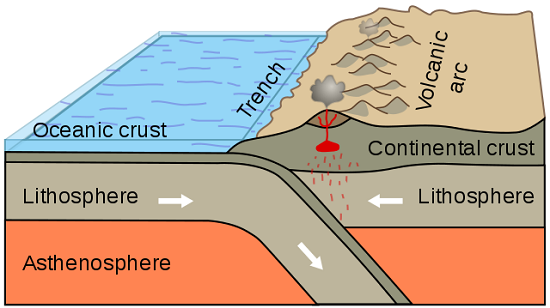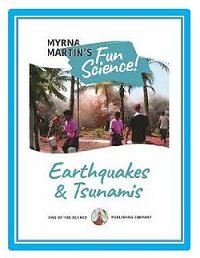What are Convergent Boundaries?
Subduction Zones are convergent boundaries
Forming a subduction zone
Convergent boundaries form when two crustal plates are colliding. When a continental plate and an ocean plate converge the ocean plate is heavier and subducts beneath the continental plate. The plates form a subduction zone with one plate descending beneath the other plate. Two ocean plates converge forming a subduction zone also.
Collision zones
Two continental plates colliding form a collision zone. The two continental plates instead form mountain ranges like the Himalayas.

Convergent boundary in a subduction zone between a continental plate and an oceanic plate. USGS
Recycling the ocean crust
Subduction zone
The subducting plate is being recycled as it begins to melt at about 100 kilometers. The water soaked oceanic plate forms molten rock that collects in magma chambers.
Buoyant molten rock
The molten rock is buoyant because it is hotter and less dense than the surrounding rocks. The rocks move up through the overlying rocks to erupt at volcanic vents forming an arc of volcanoes on the continental side of the subduction zone.


Click for More Information and to Order
Great earthquakes create tsunamis
Great earthquakes
trigger tsunamis
Tsunamis are generated during great
earthquakes by the seafloor either rising or falling along a fault line deep in
the ocean. The movement of the seafloor may be as little as 1 meter (3 feet).
The seafloor movement causes the entire column of water above to rise or drop
triggering tsunamis.
When the fault line is close to populated areas the time between the earthquake and the arrival of the first tsunami on the seashore can be only a matter of minutes. People living in low-lying areas are especially vulnerable to being swept away by tsunamis.
Causes of a megathrust earthquake
Converging plates in subduction zones often become locked. Pressure builds in the rocks until they fracture. If the break is along hundreds of kilometers of fault line a megathrust earthquake occurs.
The breaking rocks allow the overriding plate to slip over part of the subducting plate all along the fault line. The plate movement on the ocean floor can cause a tsunami. The 2004 Indian Ocean tsunami was triggered by a megathrust earthquake at a convergent boundary.
Three convergent boundaries
Continental plate and an oceanic plate converge
A continental plate converging with an oceanic plate
creates a subduction zone. Off the coast of Alaska, the Pacific Plate is
subducting beneath the North American Plate.
Two oceanic plates converge
Two oceanic plates converge creating a subduction zone
where the older heavier plate subducts beneath the younger lighter plate. The Pacific Plate is subducting beneath the Philippine Plate in the Pacific
Ocean. The Philippine Islands are an arc of volcanic islands that have formed
as the Pacific Plate melts.
Two continental crusts collide
The last convergent boundary is where two continental
crusts collide. The ocean crust that separated the two continents subducts as
the continents converge. The converging continents create great mountain ranges
between the two continental plates.
KIDS FUN Science Bookstore
Check out Myrna Martin's award winning textbooks, e-books, videos and rock sets. The Kids Fun Science Bookstore covers a wide range of earth science topics. Click here to browse.










